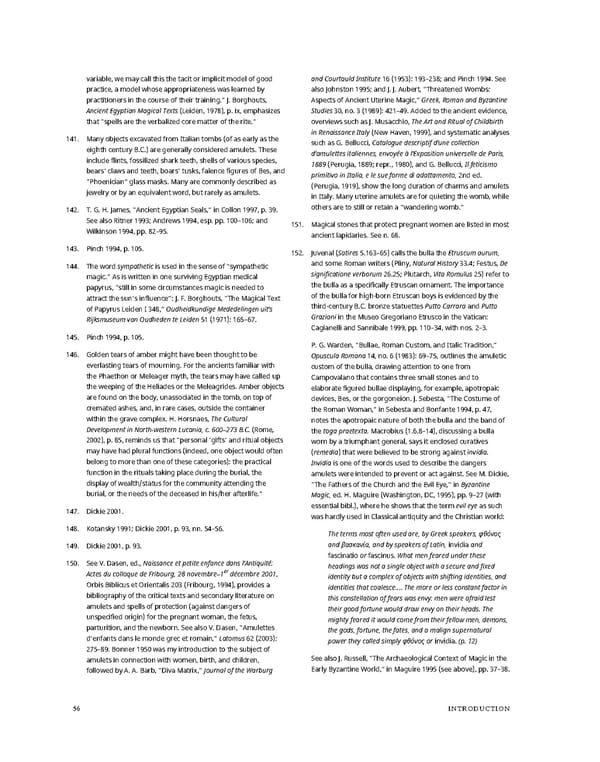variable, we may call this the tacit or implicit model of good and Courtauld Institute 16 (1953): 193–238; and Pinch 1994. See practice, a model whose appropriateness was learned by also Johnston 1995; and J. J. Aubert, “Threatened Wombs: practitioners in the course of their training.” J. Borghouts, Aspects of Ancient Uterine Magic,” Greek, Roman and Byzantine Ancient Egyptian Magical Texts (Leiden, 1978), p. ix, emphasizes Studies 30, no. 3 (1989): 421–49. Added to the ancient evidence, that “spells are the verbalized core matter of the rite.” overviews such as J. Musacchio, The Art and Ritual of Childbirth 141. Many objects excavated from Italian tombs (of as early as the in Renaissance Italy (New Haven, 1999), and systematic analyses eighth century B.C.) are generally considered amulets. These such as G. Bellucci, Catalogue descriptif d’une collection d’amulettes italiennes, envoyée à l’Exposition universelle de Paris, include flints, fossilized shark teeth, shells of various species, 1889(Perugia, 1889; repr., 1980), and G. Bellucci, Il feticismo bears’ claws and teeth, boars’ tusks, faïence figures of Bes, and primitivo in Italia, e le sue forme di adattamento, 2nd ed. “Phoenician” glass masks. Many are commonly described as (Perugia, 1919), show the long duration of charms and amulets jewelry or by an equivalent word, but rarely as amulets. in Italy. Many uterine amulets are for quieting the womb, while 142. T. G. H. James, “Ancient Egyptian Seals,” in Collon 1997, p. 39. others are to still or retain a “wandering womb.” See also Ritner 1993; Andrews 1994, esp. pp. 100–106; and 151. Magical stones that protect pregnant women are listed in most Wilkinson 1994, pp. 82–95. ancient lapidaries. See n. 68. 143. Pinch 1994, p. 105. 152. Juvenal (Satires 5.163–65) calls the bulla the Etruscum aurum, 144. The wordsympatheticis used in the sense of “sympathetic and some Roman writers (Pliny, Natural History 33.4; Festus, De magic.” As is written in one surviving Egyptian medical significatione verborum 26.25; Plutarch, Vita Romulus 25) refer to papyrus, “still in some circumstances magic is needed to the bulla as a specifically Etruscan ornament. The importance attract the sun’s influence”: J. F. Borghouts, “The Magical Text of the bulla for high-born Etruscan boys is evidenced by the of Papyrus Leiden I 348,” Oudheidkundige Mededelingen uit’s third-century B.C. bronze statuettes Putto Carrara and Putto Rijksmuseum van Oudheden te Leiden 51 (1971): 165–67. Graziani in the Museo Gregoriano Etrusco in the Vatican: Cagianelli and Sannibale 1999, pp. 110–34, with nos. 2–3. 145. Pinch 1994, p. 105. P. G. Warden, “Bullae, Roman Custom, and Italic Tradition,” 146. Golden tears of amber might have been thought to be Opuscula Romana14, no. 6 (1983): 69–75, outlines the amuletic everlasting tears of mourning. For the ancients familiar with custom of the bulla, drawing attention to one from the Phaethon or Meleager myth, the tears may have called up Campovalano that contains three small stones and to the weeping of the Heliades or the Meleagrides. Amber objects elaborate figured bullae displaying, for example, apotropaic are found on the body, unassociated in the tomb, on top of devices, Bes, or the gorgoneion. J. Sebesta, “The Costume of cremated ashes, and, in rare cases, outside the container the Roman Woman,” inSebesta and Bonfante 1994, p. 47, within the grave complex. H. Horsnaes, The Cultural notes the apotropaic nature of both the bulla and the band of Development in North-western Lucania, c. 600–273 B.C. (Rome, the toga praetexta. Macrobius (1.6.8–14), discussing a bulla 2002), p. 85, reminds us that “personal ‘gifts’ and ritual objects worn by a triumphant general, says it enclosed curatives may have had plural functions (indeed, one object would often (remedia) that were believed to be strong against invidia. belong to more than one of these categories): the practical Invidia is one of the words used to describe the dangers function in the rituals taking place during the burial, the amulets were intended to prevent or act against. See M. Dickie, display of wealth/status for the community attending the “The Fathers of the Church and the Evil Eye,” in Byzantine burial, or the needs of the deceased in his/her afterlife.” Magic, ed. H. Maguire (Washington, DC, 1995), pp. 9–27 (with 147. Dickie 2001. essential bibl.), where he shows that the term evil eye as such was hardly used in Classical antiquity and the Christian world: 148. Kotansky 1991; Dickie 2001, p. 93, nn. 54–56. The terms most often used are, by Greek speakers, φθόνος 149. Dickie 2001, p. 93. and βασκανία, and by speakers of Latin, invidia and fascinatio or fascinus. What men feared under these 150. See V. Dasen, ed., Naissance et petite enfance dans l’Antiquité: headings was not a single object with a secure and fixed Actes du colloque de Fribourg, 28 novembre–1er décembre 2001, identity but a complex of objects with shifting identities, and Orbis Biblicus et Orientalis 203 (Fribourg, 1994), provides a identities that coalesce.… The more or less constant factor in bibliography of the critical texts and secondary literature on this constellation of fears was envy: men were afraid lest amulets and spells of protection (against dangers of their good fortune would draw envy on their heads. The unspecified origin) for the pregnant woman, the fetus, mighty feared it would come from their fellow men, demons, parturition, and the newborn. See also V. Dasen, “Amulettes the gods, fortune, the fates, and a malign supernatural d’enfants dans le monde grec et romain,” Latomus 62 (2003): power they called simply φθόνος or invidia. (p. 12) 275–89. Bonner 1950 was my introduction to the subject of amulets in connection with women, birth, and children, See also J. Russell, “The Archaeological Context of Magic in the followed by A. A. Barb, “Diva Matrix,” Journal of the Warburg Early Byzantine World,” in Maguire 1995 (see above), pp. 37–38. 56 INTRODUCTION
 Ancient Carved Ambers in the J. Paul Getty Museum Page 65 Page 67
Ancient Carved Ambers in the J. Paul Getty Museum Page 65 Page 67